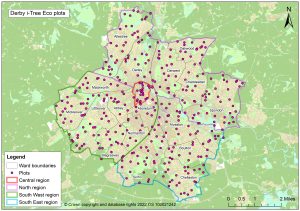Summary
Introduction
In summer 2021 Forest Research worked with Derby City Council to undertake an i-Tree Eco survey in the city.
Derby has 17 electoral wards. 350 sample plots were laid out across the city, to enable analysis of the urban forest in each ward.

At each plot surveyors recorded data about the trees, shrubs, ground cover, and land use. Using the field data and i-Tree Eco v6 we assessed the composition and structure of Derby’s urban forest. We analysed species diversity, risks from pests and diseases, and the range of tree ages in the city. i-Tree Eco enabled us to calculate the ecosystem services provided by Derby’s trees.
We calculated the CAVAT value of Derby’s trees, to estimate the value of the amenity provided by the trees to people in the city.
Research Objectives
This project aimed to:
- Assess the structure and composition of Derby city’s trees
- Calculate the amount and value of benefits provided by trees in each of the wards in Derby
- Investigate the resilience and sustainability of Derby’s urban forest
Findings and Recommendations
Findings
- Ecosystem services provided by Derby’s trees are worth £3.3 million per year.
- There are around 255,000 trees in Derby, with at least 61 different species.
- The most common species are Leyland cypress (Cupressus x leylandii), Sycamore (Acer pseudoplatanus), and Silver birch (Betula pendula).
- Derby’s urban forest has good species richness, diversity, and size class distribution compared to several other UK cities. In particular, Derby has a lot of large trees.
- Most of Derby’s trees are found on private land uses such as residential areas. This means ecosystem services are centred on private land.
- The total CAVAT (amenity) value of all of Derby’s trees is estimated to be over £1 billion.
Recommendations
- Enhance and review Tree Preservation Orders, and engage residents in stewardship, to reduce the risk of tree removals from private land.
- Combine spatial and socio-economic data to identify opportunities to expand canopy cover in the areas of greatest need.
- Plant a mix of native and non-native species and follow guidance on provenance, pests and disease, and drought tolerance.
- Plant large-stature trees and protect existing trees that have reached a large size in maturity.
Latest Update
Surveying of over 300 plots was completed in September 2021. Data processing and analysis has been completed, and the final reports are now available in the Downloads’ section on this page.
Downloads
Funding & Partners
-
 Derby City Council
Derby City Council -
 Treeconomics
Treeconomics -
 Forest Research
Forest Research



